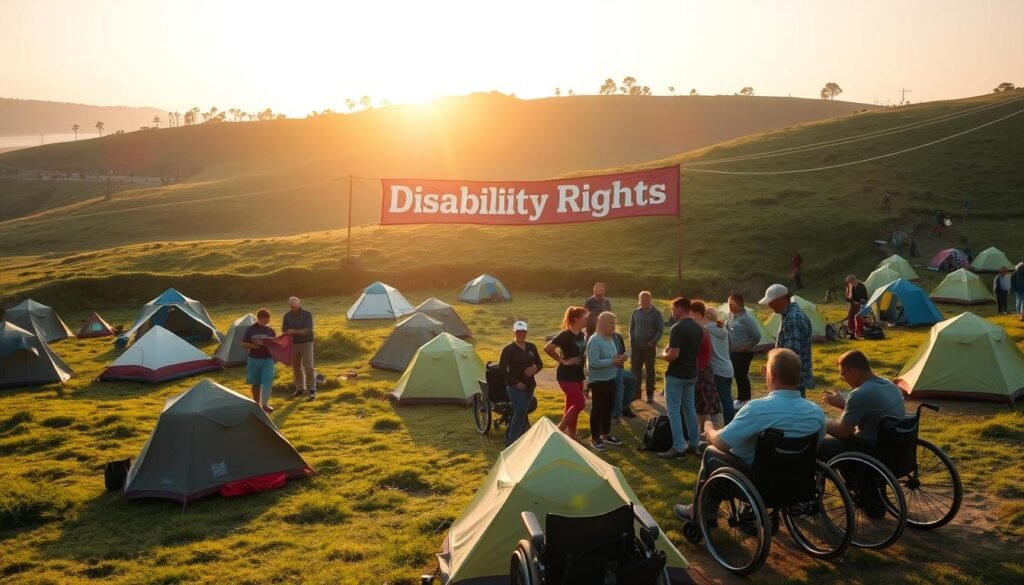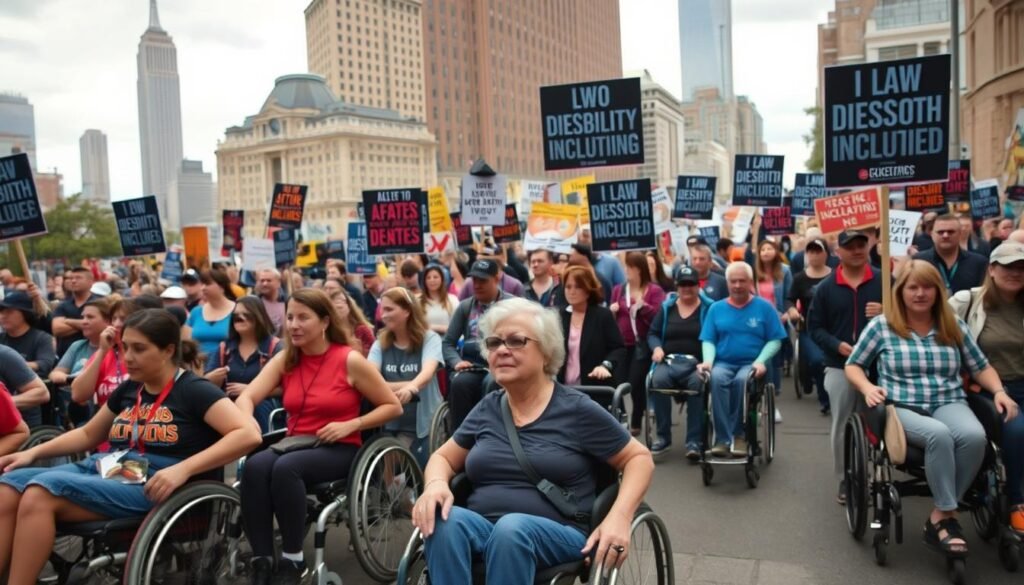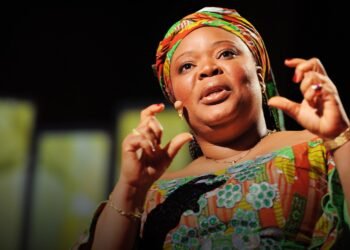What if one person’s refusal to accept “no” could change the world for millions? This question lies at the heart of a remarkable life dedicated to justice and equality.
Judith Ellen Heumann, often called the “Mother of the Disability Rights Movement”, was a powerful force for change. Born in 1947, she spent her life fighting for the civil rights of disabled people.
Her work helped create laws that protect the rights of children and adults with disabilities. She brought these issues to the global stage through her roles at the World Bank and State Department.
This article explores her incredible journey and lasting impact on the movement for disability rights.
Key Takeaways
- Judy Heumann is known as the “Mother of the Disability Rights Movement”.
- She was a lifelong advocate for the civil rights of people with disabilities.
- Her work led to important human rights legislation and policies.
- She helped mainstream disability rights in international development.
- Heumann significantly expanded the independent living movement.
- Her advocacy created lasting change for disabled individuals worldwide.
Early Life and the Foundation of an Activist
The foundation of Judy Heumann’s activism was laid during her childhood, marked by both exclusion and empowerment. Her early experiences with discrimination and community building shaped her understanding of disability rights.
Contracting Polio and Facing Educational Barriers
At just 18 months of age, she contracted polio. This led to her lifelong use of a wheelchair. The experience shaped her perspective on disability from her earliest years.
Her local public school in Brooklyn, New York refused her entry. Administrators called her a “fire hazard.” This discriminatory policy kept her from receiving proper education.
She received limited home instruction instead. Her mother challenged this exclusion fiercely. This maternal activism eventually forced the system to change.
After this victory, she attended a special school. Later, she was able to enter public high school. Her mother’s fight taught her the power of challenging unjust systems.
The Transformative Experience of Camp Jened
From ages 9 to 18, she attended Camp Jened in Hunter, New York. This camp was for children with disabilities. Here she found community and shared experiences.
For the first time, she connected with other disabled individuals. They shared frustrations about exclusion and accessibility. This created a powerful sense of solidarity.
The camp experience deeply influenced her future activism. It was featured in the documentary “Crip Camp.” There she met fellow activists like Bobbi Linn and Freida Tankus.

She graduated from Long Island University in 1969. During college, she organized rallies for accessibility. This early activism foreshadowed her future work.
Later, she earned a Master of Science in public health from UC Berkeley. This education in 1975 strengthened her advocacy tools. She learned to fight for inclusion and rights systematically.
These early experiences built a strong foundation. They taught her to challenge barriers and build community. This prepared her for a lifetime of disability rights advocacy.
Pioneering Legal and Direct Action for Disability Rights
The fight for disability rights entered a new phase through groundbreaking legal challenges and direct action. Strategic lawsuits and organized protests became powerful tools for change. These methods would shape the movement for decades to come.
Heumann v. Board of Education of the City of New York
In 1970, a landmark case challenged employment discrimination. The New York Board of Education denied a teaching license to a qualified candidate. They cited her wheelchair as a fire hazard.
The lawsuit fought this discriminatory practice. It resulted in a settlement that made history. The plaintiff became the first wheelchair user to teach in New York City schools.
This victory proved that legal action could break down barriers. It set an important precedent for employment rights. People with disabilities could now pursue teaching careers.
Founding Disabled in Action (DIA)
The same year saw the creation of a new advocacy organization. Disabled in Action (DIA) focused on securing civil rights protections. It used political protest to challenge discrimination.
The group organized demonstrations against vetoes of the Rehabilitation Act. They brought visibility to the struggle for equal rights. DIA became a powerful voice for the community.
This organization represented a shift in advocacy strategies. It embraced direct action and public confrontation. These methods would prove highly effective.
Leading the Historic 504 Sit-in in San Francisco
In 1977, a dramatic protest captured national attention. Activists occupied a federal building for 28 days. They demanded meaningful regulations for Section 504 of the Rehabilitation Act.
This became the longest sit-in at a federal building in U.S. history. The protest required careful planning and community support. Participants faced significant challenges during the occupation.
Collaboration was essential for the protest’s success. The Black Panther Party provided meals to sustain the activists. Creative strategies were developed to store necessary medication.

The persistence paid off with a major victory. Joseph Califano signed the Section 504 regulations. This marked a significant achievement for disability rights.
The regulations set a precedent for future legislation. They influenced later laws like the Americans with Disabilities Act. The protest showed the power of direct action.
These actions pioneered new approaches to advocacy. They combined legal challenges with grassroots organizing. This shifted public perception and legal frameworks dramatically.
The work of Judy Heumann was central to these efforts. Her leadership in these campaigns created lasting change. The disability rights movement was forever transformed.
A Career of Influence: From Policy to Global Advocacy
From street protests to presidential appointments, the advocacy work entered halls of power. This shift marked a new era for the disability rights movement.
Strategic positions allowed for systemic change through policy implementation. The fight expanded from national to international arenas.
Co-founding the World Institute on Disability (WID)
In 1983, a groundbreaking organization emerged with disabled leadership. The World Institute on Disability was founded with Ed Roberts and Joan Leon.
This was among the first global groups led by people with disabilities. It focused on policy research and advocacy for civil rights.
WID developed innovative approaches to independent living issues. The institute addressed barriers in transportation, employment, and healthcare.
For ten years, the co-director helped shape national disability policy. The organization’s research informed legislation and program development.
This work created lasting frameworks for disability inclusion worldwide.
Assistant Secretary of Education under President Clinton
The Clinton administration brought new opportunities for policy implementation. From 1993 to 2001, a key role oversaw critical programs.
As Assistant Secretary for Special Education and Rehabilitative Services, responsibilities were vast. This position managed federal programs serving millions with disabilities.
The office implemented legislation affecting youth and adults nationwide. Programs supported education, employment, and independent living.
This work built upon earlier efforts with the Individuals with Disabilities Education Act. The role demonstrated how government could advance disability rights effectively.
Special Advisor for International Disability Rights under President Obama
Global disability inclusion became a diplomatic priority in 2010. The first Special Advisor for International Disability Rights was appointed.
This historic position at the State Department broke new ground. It mainstreamed disability rights in U.S. foreign policy and development work.
The advisor promoted inclusion in international programs and agreements. Efforts included advocating for UN Convention on the Rights of Persons with Disabilities ratification.
Though ratification wasn’t achieved, awareness grew significantly. The role previously included similar work at the World Bank from 2002.
There, disability was integrated into development projects for the first time. This global perspective expanded the movement’s impact beyond national borders.
These roles demonstrated how policy work could create worldwide change for people with disabilities.
Media, Memoir, and Mainstream Recognition
As the disability rights movement gained momentum, new platforms emerged to share powerful stories. Media became a crucial tool for raising awareness and celebrating achievements.
Authoring “Being Heumann: An Unrepentant Memoir”
In 2020, a powerful personal account reached readers worldwide. “Being Heumann: An Unrepentant Memoir of a Disability Rights Activist” shared decades of advocacy work.
The book detailed her journey from childhood to international leadership. It brought the struggle for civil rights to a broader audience.
Readers gained insight into the personal side of the movement. The memoir became an important resource for understanding disability history.
Featured in the Acclaimed Documentary “Crip Camp”
The same year brought another significant media project to audiences. The Oscar-nominated documentary “Crip Camp” explored early community building.
This film highlighted experiences at Camp Jened and their impact on activism. It showed how shared experiences fueled the disability rights movement.
The documentary received critical acclaim and numerous awards. It introduced new generations to the history of people with disabilities fighting for equality.
A Legacy of Awards and Honors
Recognition came through numerous prestigious awards over the years. In 2022, BBC named her one of their 100 Women honorees.
Time Magazine awarded a retrospective 1977 Woman of the Year title in 2020. The Henry Viscardi Achievement Award also honored her contributions that same year.
Honorary doctorates from Brooklyn College and New York University celebrated her academic impact. The Society for Disability Studies presented its President’s Award.
Additional honors came from the National Council on Independent Living. These recognitions solidified her status as a transformative leader.
Media appearances extended her influence through popular platforms. A 2017 TEDTalk reached millions with its message about inclusion.
An interview on “The Daily Show” with Trevor Noah brought disability rights to mainstream audiences. These appearances helped normalize discussions about accessibility.
In 2021, “The Heumann Perspective” podcast launched featuring conversations with disabled change-makers. This platform continued her work of amplifying diverse voices.
Together, these media efforts and honors created lasting awareness. They ensured that the fight for disability rights remained visible and relevant.
Conclusion: The Enduring Legacy of Judy Heumann
Judy Heumann passed away in Washington, D.C. on March 4, 2023. She was 75 years old. Her life’s work reshaped disability rights worldwide.
Her powerful mantra, “nothing about us without us,” guided her advocacy. This philosophy emphasized that people with disabilities must lead their own movement.
Heumann’s efforts led to major laws like the Americans with Disabilities Act. She also promoted global inclusion through her State Department role.
She mentored many activists and supported the independent living movement. Her marriage to Jorge Pineda was part of her full life.
Heumann remains the “Mother of the Disability Rights Movement”. Her call for continued progress in equity and inclusion still inspires action today.
FAQ
What was the significance of the 504 Sit-in?
The 504 Sit-in was a historic protest in San Francisco that lasted 25 days. It was a pivotal moment for the disability rights movement, directly leading to the signing of Section 504 of the Rehabilitation Act. This legislation was the first major federal law to prohibit discrimination against people with disabilities.
Why was Judy Heumann denied a teaching license?
The New York City Board of Education initially denied her a teaching license, deeming her wheelchair a fire hazard. She successfully sued the board in the case *Heumann v. Board of Education*, a landmark legal victory that established a precedent against such discrimination.
What organizations did Judy Heumann help found?
She was a key founder of several major organizations, including Disabled in Action (DIA), which focused on legal advocacy and protests, and the World Institute on Disability (WID), a pioneering research and policy center run by and for disabled individuals.
What government roles did she hold?
She served as the Assistant Secretary for the Office of Special Education and Rehabilitative Services under President Clinton. Later, she was appointed the first Special Advisor for International Disability Rights for the U.S. State Department under President Obama.
How did Camp Jened influence her activism?
Her time at Camp Jened, a summer camp for people with disabilities, was transformative. It was a rare place where she experienced a true community of equals, free from societal prejudice. This experience fueled her belief in the possibility of an integrated and accessible world.
Where can I learn more about her life and work?
Her story is powerfully told in her memoir, *Being Heumann: An Unrepentant Memoir of a Disability Rights Activist*, and in the Oscar-nominated Netflix documentary *Crip Camp: A Disability Revolution*, which highlights her early years and activism.





